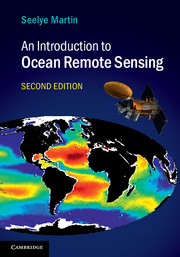Book contents
- Frontmatter
- Contents
- Preface
- List of chemical symbols
- List of mathematical symbols
- List of abbreviations and acronyms
- 1 Background
- 2 Ocean surface phenomena
- 3 Electromagnetic radiation
- 4 Atmospheric properties and radiative transfer
- 5 Reflection, transmission and absorption at the atmosphere/ocean interface
- 6 Ocean color
- 7 Infrared observations of sea surface temperature (SST)
- 8 Introduction to microwave imagers
- 9 Passive microwave observations of the atmosphere and ocean surface
- 10 Introduction to radars
- 11 Scatterometers
- 12 The altimeter
- 13 Imaging radars
- 14 Other instruments: the gravity missions, ICESat-1 and -2, CryoSat-2, SMOS and Aquarius/SAC-D
- Appendix
- References
- Index
- Plate Section
13 - Imaging radars
Published online by Cambridge University Press: 05 June 2014
- Frontmatter
- Contents
- Preface
- List of chemical symbols
- List of mathematical symbols
- List of abbreviations and acronyms
- 1 Background
- 2 Ocean surface phenomena
- 3 Electromagnetic radiation
- 4 Atmospheric properties and radiative transfer
- 5 Reflection, transmission and absorption at the atmosphere/ocean interface
- 6 Ocean color
- 7 Infrared observations of sea surface temperature (SST)
- 8 Introduction to microwave imagers
- 9 Passive microwave observations of the atmosphere and ocean surface
- 10 Introduction to radars
- 11 Scatterometers
- 12 The altimeter
- 13 Imaging radars
- 14 Other instruments: the gravity missions, ICESat-1 and -2, CryoSat-2, SMOS and Aquarius/SAC-D
- Appendix
- References
- Index
- Plate Section
Summary
Introduction
Side-looking imaging radars provide a powerful way to retrieve ice and ocean surface backscatter properties at a high resolution and for nearly all weather conditions. Given that many geophysical processes modulate the Bragg scattering waves, the returns from these radars can be formed into images that display a wide variety of surface phenomena. Other advantages are that, depending on the processing, the resolution can be of order meters, and at the frequencies used by these radars, the atmosphere is transparent except for heavy rain.
There are two kinds of satellite imaging radars: synthetic aperture radar (SAR) and the real-aperture side-looking radar (SLR). The SLR is a range-binned instrument with a surface resolution of about 1 km; the SAR is a more complicated instrument with resolutions as fine as 3 m. Because the radar pulses illuminate the surface, the instruments provide day and night coverage. SAR is the principal radar imager used in oceanographic research, where SARs have been flown by the United States, Canada, ESA, Germany, Italy, Japan and Russia. Because the SLR operates similarly to SAR in the cross-track direction and was used by Russia and Ukraine for sea ice monitoring through the year 2000, this chapter covers both instruments but emphasizes SAR.
Information
- Type
- Chapter
- Information
- An Introduction to Ocean Remote Sensing , pp. 401 - 435Publisher: Cambridge University PressPrint publication year: 2014
